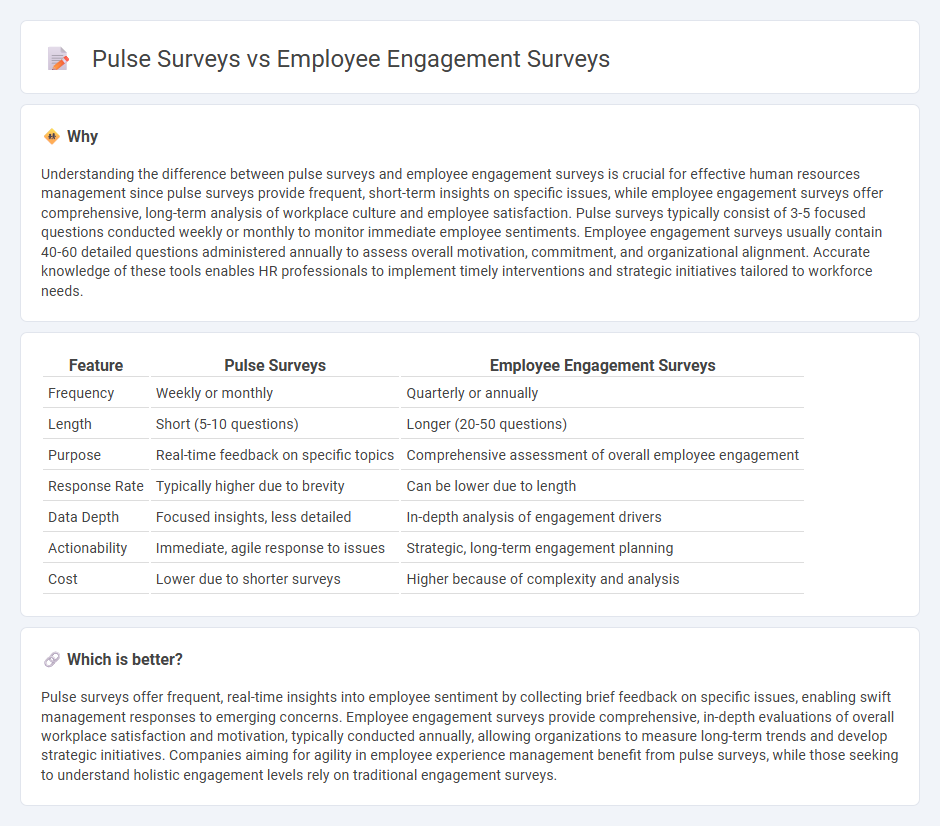
Pulse surveys offer concise, frequent insights into employee sentiments, enabling real-time adjustments to workplace dynamics. Employee engagement surveys provide comprehensive, in-depth analysis of workforce motivation, satisfaction, and commitment, typically conducted annually or biannually. Discover how integrating both methods can enhance your human resources strategy and boost organizational performance.
Why it is important
Understanding the difference between pulse surveys and employee engagement surveys is crucial for effective human resources management since pulse surveys provide frequent, short-term insights on specific issues, while employee engagement surveys offer comprehensive, long-term analysis of workplace culture and employee satisfaction. Pulse surveys typically consist of 3-5 focused questions conducted weekly or monthly to monitor immediate employee sentiments. Employee engagement surveys usually contain 40-60 detailed questions administered annually to assess overall motivation, commitment, and organizational alignment. Accurate knowledge of these tools enables HR professionals to implement timely interventions and strategic initiatives tailored to workforce needs.
Comparison Table
| Feature | Pulse Surveys | Employee Engagement Surveys |
|---|---|---|
| Frequency | Weekly or monthly | Quarterly or annually |
| Length | Short (5-10 questions) | Longer (20-50 questions) |
| Purpose | Real-time feedback on specific topics | Comprehensive assessment of overall employee engagement |
| Response Rate | Typically higher due to brevity | Can be lower due to length |
| Data Depth | Focused insights, less detailed | In-depth analysis of engagement drivers |
| Actionability | Immediate, agile response to issues | Strategic, long-term engagement planning |
| Cost | Lower due to shorter surveys | Higher because of complexity and analysis |
Which is better?
Pulse surveys offer frequent, real-time insights into employee sentiment by collecting brief feedback on specific issues, enabling swift management responses to emerging concerns. Employee engagement surveys provide comprehensive, in-depth evaluations of overall workplace satisfaction and motivation, typically conducted annually, allowing organizations to measure long-term trends and develop strategic initiatives. Companies aiming for agility in employee experience management benefit from pulse surveys, while those seeking to understand holistic engagement levels rely on traditional engagement surveys.
Connection
Pulse surveys and employee engagement surveys both measure workforce sentiment but differ in frequency and scope; pulse surveys are short, frequent check-ins designed to track real-time employee feelings, while engagement surveys are comprehensive assessments conducted periodically to evaluate overall commitment and satisfaction. Data from pulse surveys can identify trends and immediate issues, informing targeted interventions that enhance the insights gained from less frequent engagement surveys. Integrating pulse survey feedback with engagement survey results enables HR teams to develop dynamic strategies that boost morale, retention, and productivity.
Key Terms
Frequency
Employee engagement surveys are typically conducted annually or biannually, providing a comprehensive overview of workforce sentiment over an extended period. Pulse surveys occur more frequently, often monthly or quarterly, delivering real-time insights into employee morale and allowing for quicker response to emerging issues. Explore how the optimal survey frequency can transform your organizational culture and drive productivity.
Depth of Feedback
Employee engagement surveys provide comprehensive insights by covering a wide range of topics related to workplace satisfaction, motivation, and overall employee experience, enabling organizations to identify deep-rooted issues. Pulse surveys, on the other hand, offer quick, frequent check-ins that capture real-time employee sentiment but typically generate less detailed feedback on specific areas. Explore our detailed analysis to understand which survey approach best suits your organizational goals and enhances employee engagement strategy.
Actionability
Employee engagement surveys provide comprehensive insights into workplace culture and employee satisfaction, often conducted annually or biannually. Pulse surveys offer real-time, frequent feedback on specific issues or changes, enabling faster response and targeted interventions. Explore how choosing between these survey types can enhance actionability and improve organizational outcomes.
Source and External Links
Employee Engagement Surveys: Ultimate Guide - This guide provides insights and strategies for using employee engagement surveys to improve company culture and detect dissatisfaction among employees.
Top Employee Engagement Survey Vendors - This webpage lists top vendors for employee engagement surveys and highlights their importance in modern workplace dynamics.
Employee Engagement Surveys: The Questions to Ask - This resource offers templates and sample questions for creating effective employee engagement surveys to boost engagement and reduce attrition.
 dowidth.com
dowidth.com